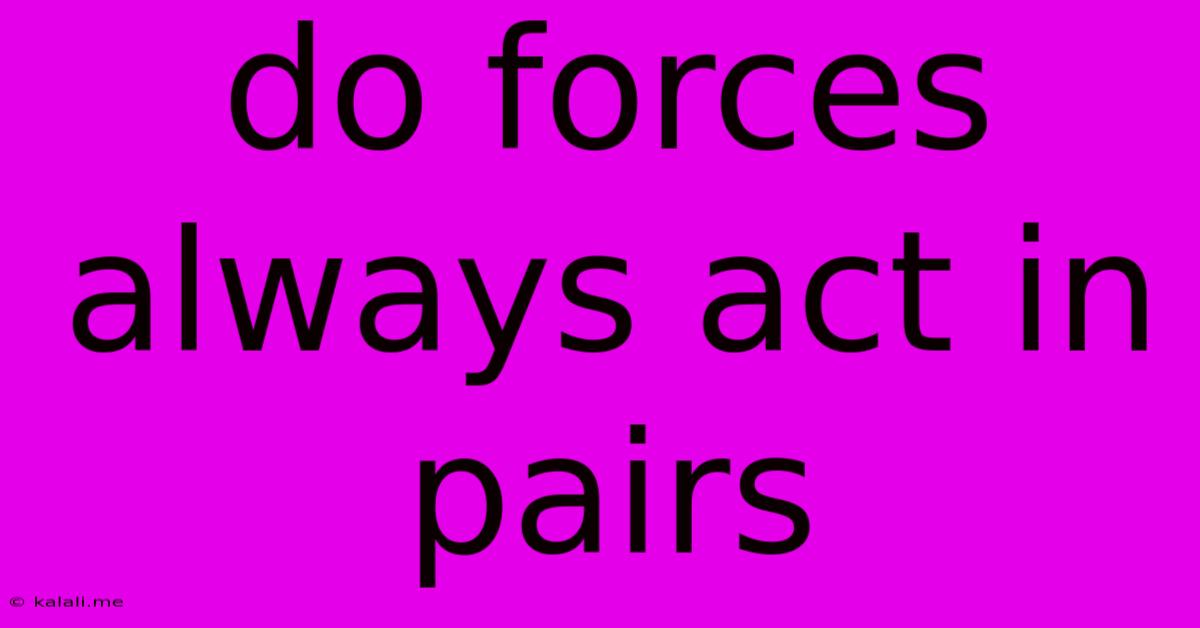Do Forces Always Act In Pairs
Kalali
May 21, 2025 · 3 min read

Table of Contents
Do Forces Always Act in Pairs? Understanding Newton's Third Law
This article delves into Newton's Third Law of Motion, exploring the concept of action-reaction pairs and clarifying some common misconceptions surrounding this fundamental principle of physics. We'll examine real-world examples and address situations where the paired forces might seem less obvious. Understanding this law is crucial for comprehending many aspects of mechanics and dynamics.
Newton's Third Law: For Every Action, There's an Equal and Opposite Reaction
Newton's Third Law states that for every action, there is an equal and opposite reaction. This means that whenever one object exerts a force on a second object, the second object simultaneously exerts a force equal in magnitude and opposite in direction on the first object. These forces are often referred to as action-reaction pairs. It's crucial to remember that these forces act on different objects; they don't cancel each other out.
Understanding Action-Reaction Pairs: Key Considerations
Several points are key to understanding action-reaction pairs correctly:
- Equal Magnitude, Opposite Direction: The forces are always equal in strength but act in opposite directions. This doesn't imply that the effects on the objects are the same. The effect of a force depends on the mass of the object it acts upon (Newton's Second Law: F=ma).
- Simultaneous Action: The action and reaction forces occur at the same time. They are not sequential events, but rather a simultaneous interaction.
- Different Objects: It's crucial to remember that the action and reaction forces act on different objects. This is a common point of confusion. They don't cancel each other out because they act on separate bodies.
Examples of Action-Reaction Pairs
Let's consider some examples to illustrate this principle:
- Walking: When you walk, you push backward on the ground (action). The ground, in turn, pushes forward on your feet (reaction), propelling you forward.
- Swimming: You push backward on the water (action), and the water pushes forward on you (reaction), allowing you to move through the water.
- Rocket Launch: A rocket expels hot gases downward (action). The gases exert an upward force on the rocket (reaction), causing it to lift off.
- A Book on a Table: The book exerts a downward force on the table due to gravity (action). The table exerts an upward force on the book (reaction), preventing it from falling through the table. This upward force is called the normal force.
Addressing Common Misconceptions
One common misconception is that the action and reaction forces cancel each other out. This is incorrect. Since they act on different objects, they cannot cancel. The net force on each object is determined by the vector sum of all forces acting on that object.
Conclusion: The Significance of Action-Reaction Pairs
Newton's Third Law is fundamental to our understanding of how forces interact in the physical world. While seemingly simple, the concept of action-reaction pairs is often misunderstood. This article aimed to clarify the core principles, provide illustrative examples, and address common misconceptions. By understanding action-reaction pairs, we gain a deeper understanding of motion, equilibrium, and the interactions between objects. This knowledge is essential across numerous fields, including engineering, aerospace, and sports science.
Latest Posts
Latest Posts
-
How Many Grams Of Caffeine In A Coffee
May 21, 2025
-
Why Does The Reactivity Increase In Group 1
May 21, 2025
-
What Is A Fraction Line Called
May 21, 2025
-
Synonym For In The Same Vein
May 21, 2025
-
The Word With The Most Vowels
May 21, 2025
Related Post
Thank you for visiting our website which covers about Do Forces Always Act In Pairs . We hope the information provided has been useful to you. Feel free to contact us if you have any questions or need further assistance. See you next time and don't miss to bookmark.